A Survey on the Design of Gamified Systems for Energy and Water Sustainability
Abstract
1. Introduction
2. Human Computation, Gamification and Games with a Purpose
- Gamified applications: These are conventional application addressing a business goal (e.g., water or energy billing), extended with features normally found in games, to promote user’s engagement and activity [8].
- Games with a Purpose (GWAPs): GWAPs focus on exploiting the natural attractiveness of games to recruit people to solve complex problems that involve human intelligence [9,10]. They embed a problem-solving task into an enjoyable user experience, which can be conducted by individuals or groups. Several game design paradigms have been studied [10] and the mechanics of users’ involvement has begun to be modeled formally [11]. GWAPs have addressed such tasks as adding descriptive tags and recognising objects in images, checking the output of Optical Character Recognition (OCR) for correctness, helping protein folding and multiple sequence alignment algorithms in molecular biology and comparative genomic research [12].
- Social Mobilisation: This approach addresses problems with time constraints, where the efficiency of task spreading and of solution finding is essential. The DARPA Network Challenge [13] is a notable example: the teams had to determine the coordinates of ten red weather balloons placed at unknown locations in the United States. The winning team employed a novel recursive incentive mechanism that permitted them to locate all balloons in less than nine hours. Applications are also found in safety critical sectors, such as civil protection [14] and disease control [15].
- Human sensors: These approaches exploit the diffusion of mobile terminals and the fact that more and more of these devices are equipped with sensors [16,17] to trigger the real-time collection of data to realise time-critical decision support systems and emergency management. Application areas include pollution monitoring [18], traffic and road condition control [19,20], and earthquake monitoring [21]. Human behavioural patterns in the usage of mobile phones have also been exploited to detect levels of activity to examine the effects of the spreading of seasonal diseases [22].
- Crowdsourcing: This approach manages the assignment of work to an open community of executors [23], typically with a Web interface that can be used by work providers, who can specify the piece of work they need (e.g., collecting addresses of business companies, classifying products by category, geo-referencing location names, etc.); and by work performers, who can enrol, declare their skills, and take up and perform a piece of work. In addition to the web interface, some platforms offer Application Programming Interfaces (APIs), whereby third parties can integrate the distributed work management functionality into their custom applications. Examples of crowdsourcing solutions are Amazon Mechanical Turk [24] and Microtask.com [25]. Application areas are the most varied: speech transcription, translation, form filling, content tagging, and user evaluation studies are a few examples.
2.1. Gamified Applications
2.2. Games with a Purpose (GWAPs)
3. Persuasive System Design Theory
3.1. Fogg’s Behaviour Model
- A spark: This type of trigger is designed for people lacking motivation to perform according to the target behaviour and leverages motivational elements inspiring an emotional reaction (e.g., hope or fear).
- A facilitator: This trigger targets users that have high motivation but lack ability. It tries to convince them that achieving the target behaviour is easier than what they believe.
- A signal: This trigger is used when people have both the ability and the motivation to perform the target behaviour. A signal simply serves as a reminder to engage in the target behaviour.
3.2. Oinas–Kukkonen’s Persuasive System Design (PSD) Model
3.2.1. Design postulates
- P1
- ICT is never neutral, as the introduction of an ICT system always has some influence on the user. In that sense, persuasion should be considered as a process during which the goals of the user may change, and not as a single event. BCSSs should be able to cope with such changes over time.
- P2
- Consistency is needed, as people like their views of the world to be consistent. This postulate indicates potential for behavioural change, since, by pointing out inconsistencies between, e.g., attitudes and behaviour, people are inclined to change their behaviour when the dissonance is strong enough.
- P3
- Direct and indirect routes to persuasion must be employed: users who are capable of actively processing the content of the persuasive message can be persuaded via direct strategies, whereas users who rely on simple cues and heuristics for evaluating the message content should be approached via indirect routes.
- P4
- Persuasion is often of incremental nature, rather than radical. A BCSS should enable users to make incremental steps towards the target behaviour, while clearly communicating the final goal. Encouraging users to perform small incremental steps is easier than persuading them to take big steps.
- P5
- The designed system should serve the envisioned purposes while meeting generic usability and system performance criteria, such as responsiveness, lack of errors, quality of information, visual appeal, ease-of-use, etc.
- P6
- Persuasion through a BCSS must be unobtrusive to a user’s primary tasks. This postulate implies that an opportune moment should be identified at which the persuasive message can be delivered without disrupting the user’s primary activities.
- P7
- Persuasion must always be transparent. This postulate requires to be open about the designer and the assumptions behind the BCSS to avoid losing its trustworthiness and persuasive potential.
3.2.2. The Persuasion Context
3.2.3. Persuasive Software Features
3.3. Gamification and GWAP Design Principles and Models
3.3.1. Bartle’s Player Categorisation
- Achievers are players who want to gain points, levels, equipment and other concrete measures of success; they are competitive and enjoy beating difficult challenges, either set by the game or by themselves. The more challenging is the goal, the more rewarded they tend to feel.
- Explorers like to explore the world, not just its geography, but also the finer details of the game mechanics. These players may end up knowing how the game works and behave better than the game creators. They know all the mechanics, short-cuts, tricks, and glitches that exist in the game and work hard on discovering more.
- Socializers are often more interested in having relations with the other players than playing the game itself. They help to spread knowledge and a human feel, and are often involved in the community aspect of the game (e.g., managing guilds or role-playing).
- Killers prefer to provoke and cause drama and impose them over other players according to the game possibilities.
3.3.2. Kim’s Social Engagement Verbs
3.3.3. Radoff’s Gameplay Model
- Immersion: Stories, roleplaying, exploration, imagination, and a sense of connectedness to the world of the game.
- Achievement: Sense of progress, mastery of skills and knowledge, etc.
- Cooperation: Player involvement in activities where they are helping each other, through creativity, shared adversity, etc.
- Competition: Player involvement where individuals complete over scarce resources, comparison, and win/loss situations.
3.3.4. Lazzaro’s Player Emotion Model
- Hard Fun: “Emotions from Meaningful Challenges, Strategies, and Puzzles” [39]. The challenge in the game focuses on attention and rewards progress for players, which creates emotion by structuring experience towards the pursuit of a goal. The game needs to have feedback on progress and success of players to inspire their creativity of strategies. Game difficulty and player skills must therefore be well balanced through levels.
- Easy Fun “grabs attention with ambiguity, incompleteness, and detail” [39]. Easy fun focuses on maintaining the player’s attention rather than on the winning condition. Ambiguity, incompleteness, and details are combined to create a living world, which satisfies players’ sense of curiosity, and induces them to play the game to discover something new. The feeling of exploration and adventure is interesting to players.
- Altered States “generate emotion with perception, thought, behaviour, and other people” [39]. These factors produce changes in the players’ internal state of mind and personal emotions by means of game stimuli.
- The people factor “creates opportunities for player competition, cooperation, performance, and spectacle” [39]. This factor is important to players who play to spend time with other people, especially with their friends. Therefore, games for social interaction and enjoyment comes from interaction with other people. Games that support both cooperative and competitive modes offer a wider variety of emotional experiences, whereas multiplayer games leverage the people factor.
3.3.5. The Hexad Framework
- Socialisers: They are motivated by interaction and social connections.
- Free Spirits: Their motivation is driven by creation, autonomy and exploration.
- Achievers: They are in a constant search for challenges, self-improvement and skill mastery are their main motivations.
- Philanthropists: The search for purpose and meaning in the activities, and helping others is their motivation and reward.
- Players: The seek to collect rewards and to compete.
- Disruptors: They are motivated by change and aim at disrupting the system in positive or negative ways.
- Intrinsic users’ motivation is strongly related with the activities or tasks they perform, motivation raises from the enjoyment and the engagement of the user in the task itself. User groups in this category are: socialisers, free spirits, achievers and philanthropists.
- Extrinsic users are mainly driven by rewards and can be subdivided into four subtypes that are analogous to the intrinsic types: Self-seekers are similar to philanthropists but they expect a reward for their help or contribution. Consumers are similar to achievers: they will learn or develop skills if there is a reward involved. Networkers are similar to socializers but they search connections they can benefit from. Finally, exploiters are similar to free spirits, but they explore the boundaries of the systems searching for ways to gain rewards from errors or holes in the system.
- Disruptors seek to disrupt other users or the system itself in any feasible way. They are divided in four subtypes: grievers, whose only motivation is to affect other users in a negative way; destroyers, who will try to break the system by hacking it or finding bugs; influencers, who try to change the way the system works by using their influence on others; and improvers, who as ethical hackers try to find problems in the system and fix them or report them.
4. Overview of Selected Gamified Systems for Sustainability and Sustainable Consumption
- Mechanics describes the type of the game.
- Roles lists the roles assumed by the players.
- Players defines the number of players that engage in a game round.
- Feedback specifies whether the game can interact with players during a round.
- Issues summarises the main problems highlighted by the game.
- Focus refers to the core persuasive/educational objective of the game.
- Target identifies a specific population of players targeted by the game.
- Data collection specifies if the game play is based on real data (e.g., actual consumption data) or aims at collecting data (e.g., photos of the environment).
- Platform specifies the technological environment/device for which the game is designed.
- Technology characterises the implementation languages and frameworks.
4.1. Energy Saving Games and Gamified Applications
4.1.1. Ecogator
4.1.2. Social Power Game
4.1.3. Makahiki
4.1.4. Power House
4.1.5. Less Energy Empowers You (LEY)
4.1.6. Wattsup
4.1.7. enCOMPASS and Funergy
4.2. Water Saving Games and Gamified Applications
4.2.1. Urban Water and Water Mansion
4.2.2. Waternomics, Water Flavors and Water Saving Calculator
4.2.3. SmartH2O and Drop!
4.3. Algorithms for Implementing Gamified Incentives
- Interaction data: These data record the interaction of the users, mediated by the (gamified) BCSSs; they can range from the simple login or start of the application, to the accomplishment of articulated tasks in a task-based application or in a sustainability-oriented gameplay.
- Sensed data: These data come from the activity of the users in the real world. In the area of sustainable resource usage, such data refer mostly to resource consumption, as recorded by smart meters or manually input by the users into the system. In other types of persuasive systems, e.g., applications for promoting healthy lifestyles, they could represent user’s activity traces (e.g., miles run, etc.).
- Gamified User Interface: The GUI for end users that allows to explore gamified objects.
- Monitoring Interface: The GUI for administrators that allows one (e.g., an utility company operator) to configure gamified objects and monitor users.
- Gamification objects: Game concepts composing the gamification mechanics (e.g., Action, Badge, Goal, and Reward).
- Thematic areas: Categories in which the gamification objects (action and badge areas) can be grouped to better reflect the different motivations of the users. Examples of such areas are: education, reputation, socialisation and consumption.
- Credits: Points that the user (player) can earn performing actions on the platform.
- Actions: Rewarded tasks the user can perform (e.g., logging in or using the app, reading a tip, watching an educational video, and inviting a friend to join the community of app users). Actions can be freely executable and always rewarded, or constrained: for example, actions could be rewarded only with a given frequency (e.g., only one login a day) or can be defined as non-repeatable (e.g., watching an educational video should be rewarded only the first time the user sees it). Across such areas, four major categories of actions are normally recognised and classified based on the source where they come from:
- -
- Consumption actions: These actions derive from the smart meter readings or user’s declared consumption. When the consumption data are received, they are elaborated to check that some of the resource saving goals has been achieved (e.g., reduction of x% over the baseline average consumption of a period, such as a week, or a month).
- -
- Application usage actions: These actions are generated as consequences of the user activity in the gamified application (e.g., login, access to a specific section of the application, etc).
- -
- Gameplay actions: These actions may be produced by a GWAP connected to the gamified application (e.g., correct answer to a energy or water trivia education game).
- -
- External actions: These actions are produced by external applications, e.g., the pre-existing portal or business system of the water or energy utility.
- Goals: Measurable objectives (e.g., energy saving goals) that can be achieved by the user.
- Badges: Virtual recognitions assigned to a user and visible to other users in the community, mostly used to demonstrate consumer status and progress. The gamification algorithms map actions to the badge they contribute to attain.
- Reward: Physical item that can be redeemed by the user, as a consequence of achieving a determined amount of credits in the persuasive applications.
- Resource saving: Refers to actual resource saving as metered by smart meters or declared by the user.
- Resource saving Insights: Refers to learning how to save resources.
- Engagement: Refers to activity in the persuasive applications and within the community of reference.
- Profiling: Refers to data input about the usage context: household, office, school, or public building.
| Algorithm 1 Algorithm for asynchronous weekly sensed data processing |
| On Monday at 6am |
| for all user in the set of resource-metered users do |
| if reading frequency day then |
| Compute new weekly average NWA |
| for all active weekly resource saving goals of user do |
| if then |
| ; |
| end if |
| end for |
| end if |
| AchievedWeeklyGoal = max (SatisfiedWeeklyGoals) |
| for all goals in AchievedWeeklyGoals do |
| ; |
| ; |
| end for; |
| ; |
| end for |
| Algorithm 2 Algorithm for synchronous weekly sensed data processing |
| loop |
| When Action of User is received |
| if ( and and or then |
| end if |
| end loop |
5. Design Patterns for Behavioural Change GWAPs and Gamified Applications
5.1. Visualisation of Behaviour
5.2. Comparison of Behaviour against Historical, Normative, or Social Reference Values
5.3. Action Tips and Personalised Recommendations
5.4. Gamification and GWAPs Elements
5.5. Social Interaction
5.6. Notifications and Reminders
6. Conclusions
Author Contributions
Funding
Conflicts of Interest
References
- Fogg, B.J. Persuasive computers: Perspectives and research directions. In Proceedings of the SIGCHI Conference on Human Factors in Computing Systems, Los Angeles, CA, USA, 18–23 April 1998; ACM Press/Addison-Wesley Publishing Co.: New York, NY, USA, 1998; pp. 225–232. [Google Scholar]
- Oinas-Kukkonen, H. A foundation for the study of behavior change support systems. Pers. Ubiquitous Comput. 2013, 17, 1223–1235. [Google Scholar] [CrossRef]
- Spagnolli, A.; Chittaro, L.; Gamberini, L. Interactive persuasive systems: A perspective on theory and evaluation. Int. J. Hum.-Comput. Interact. 2016, 32, 177–189. [Google Scholar] [CrossRef]
- Michie, S.; van Stralen, M.M.; West, R. The behaviour change wheel: A new method for characterising and designing behaviour change interventions. Implement. Sci. 2011, 6, 42. [Google Scholar] [CrossRef] [PubMed]
- Von Ahn, L. Human computation. In Proceedings of the IEEE 24th International Conference on Data Engineering, ICDE 2008, Cancún, Mexico, 7–12 April 2008; IEEE: Piscataway, NJ, USA, 2008; pp. 1–2. [Google Scholar]
- Quinn, A.J.; Bederson, B.B. Human computation: A survey and taxonomy of a growing field. In Proceedings of the SIGCHI Conference on Human Factors in Computing Systems, Vancouver, BC, Canada, 7–12 May 2011; ACM: New York, NY, USA, 2011; pp. 1403–1412. [Google Scholar]
- Parameswaran, A.; Sarma, A.D.; Garcia-Molina, H.; Polyzotis, N.; Widom, J. Human-assisted graph search: It’s okay to ask questions. Proc. VLDB Endow. 2011, 4, 267–278. [Google Scholar] [CrossRef]
- Deterding, S.; Dixon, D.; Khaled, R.; Nacke, L. From game design elements to gamefulness: Defining gamification. In Proceedings of the 15th International Academic MindTrek Conference: Envisioning Future Media Environments, Tampere, Finland, 28–30 September 2011; ACM: New York, NY, USA, 2011; pp. 9–15. [Google Scholar]
- Von Ahn, L. Games with a purpose. Computer 2006, 39, 92–94. [Google Scholar] [CrossRef]
- Law, E.; Von Ahn, L. Input-agreement: A new mechanism for collecting data using human computation games. In Proceedings of the SIGCHI Conference on Human Factors in Computing Systems, Boston, MA, USA, 4–9 April 2009; ACM: New York, NY, USA, 2009; pp. 1197–1206. [Google Scholar]
- Chan, K.T.; King, I.; Yuen, M.C. Mathematical modeling of social games. In Proceedings of the International Conference on Computational Science and Engineering, CSE’09, Vancouver, BC, Canada, 29–31 August 2009; IEEE: Piscataway, NJ, USA, 2009; Volume 4, pp. 1205–1210. [Google Scholar]
- Cooper, S.; Khatib, F.; Treuille, A.; Barbero, J.; Lee, J.; Beenen, M.; Leaver-Fay, A.; Baker, D.; Popović, Z.; Players, F. Predicting protein structures with a multiplayer online game. Nature 2010, 466, 756–760. [Google Scholar] [CrossRef] [PubMed]
- Pickard, G.; Pan, W.; Rahwan, I.; Cebrian, M.; Crane, R.; Madan, A.; Pentland, A. Time-critical social mobilization. Science 2011, 334, 509–512. [Google Scholar] [CrossRef] [PubMed]
- Hamilton, M.; Salim, F.; Cheng, E.; Choy, S.L. Transafe: A crowdsourced mobile platform for crime and safety perception management. ACM SIGCAS Comput. Soc. 2011, 41, 32–37. [Google Scholar] [CrossRef]
- Stothard, J.R.; Sousa-Figueiredo, J.C.; Betson, M.; Seto, E.Y.; Kabatereine, N.B. Investigating the spatial micro-epidemiology of diseases within a point-prevalence sample: A field applicable method for rapid mapping of households using low-cost GPS-dataloggers. Trans. R. Soc. Trop. Med. Hyg. 2011, 105, 500–506. [Google Scholar] [CrossRef] [PubMed]
- Abdelzaher, T.; Anokwa, Y.; Boda, P.; Burke, J.; Estrin, D.; Guibas, L.; Kansal, A.; Madden, S.; Reich, J. Mobiscopes for human spaces. IEEE Pervasive Comput. 2007, 6, 20–29. [Google Scholar] [CrossRef]
- Campbell, A.; Eisenman, S.; Lane, N.; Miluzzo, E.; Peterson, R.; Lu, H.; Zheng, X.; Musolesi, M.; Fodor, K.; Ahn, G. The Rise of People-Centric Sensing. IEEE Internet Comput. 2008, 12, 12–21. [Google Scholar] [CrossRef]
- Dutta, P.; Aoki, P.M.; Kumar, N.; Mainwaring, A.; Myers, C.; Willett, W.; Woodruff, A. Common sense: Participatory urban sensing using a network of handheld air quality monitors. In Proceedings of the 7th ACM Conference on Embedded Networked Sensor Systems, Berkeley, CA, USA, 4–6 November 2009; ACM: New York, NY, USA, 2009; pp. 349–350. [Google Scholar]
- Manasseh, C.; Ahern, K.; Sengupta, R. The connected traveler: Using location and personalization on mobile devices to improve transportation. In Proceedings of the 2nd International Workshop on Location and the Web, Boston, MA, USA, 4 April 2009; ACM: New York, NY, USA, 2009; p. 9. [Google Scholar]
- Bansal, N.; Srivastava, B. On using crowd for measuring traffic at aggregate level for emerging countries. In Proceedings of the 8th International Workshop on Information Integration on the Web: In Conjunction with WWW 2011, Hyderabad, India, 28 March 2011; ACM: New York, NY, USA, 2011; p. 5. [Google Scholar]
- Sakaki, T.; Okazaki, M.; Matsuo, Y. Earthquake shakes Twitter users: Real-time event detection by social sensors. In Proceedings of the 19th International Conference on World Wide Web, Raleigh, NC, USA, 26–30 April 2010; ACM: New York, NY, USA, 2010; pp. 851–860. [Google Scholar]
- Madan, A.; Cebrian, M.; Lazer, D.; Pentland, A. Social sensing for epidemiological behavior change. In Proceedings of the 12th ACM International Conference on Ubiquitous Computing, Copenhagen, Denmark, 26–29 September 2010; ACM: New York, NY, USA, 2010; pp. 291–300. [Google Scholar]
- Howe, J. The rise of crowdsourcing. Wired Mag. 2006, 14, 1–4. [Google Scholar]
- Amazon Mechanical Turk. Available online: https://www.mturk.com/ (accessed on 2 May 2018).
- Microtask. Available online: https://www.microtask.com/ (accessed on 2 May 2018).
- Herger, M. Gamification Facts & Figures. Enterprise-Gamification.com, 2012. Available online: http://http://www.enterprise-gamification.com/mediawiki/index.php?title=Facts_%26_Figures (accessed on 2 May 2018).
- Gaver, W.W. Technology affordances. In Proceedings of the SIGCHI Conference on Human Factors in Computing Systems, New Orleans, LA, USA, 27 April–2 May 1991; ACM: New York, NY, USA, 1991; pp. 79–84. [Google Scholar]
- Norman Donald, A. The Psychology of Everyday Things; Basic Books: New York, NY, USA, 1988. [Google Scholar]
- Fogg, B.J. A behavior model for persuasive design. In Proceedings of the 4th International Conference on Persuasive Technology, Claremont, CA, USA, 26–29 April 2009; ACM: New York, NY, USA, 2009; p. 40. [Google Scholar]
- Oinas-Kukkonen, H.; Harjumaa, M. Persuasive systems design: Key issues, process model, and system features. Commun. Assoc. Inf. Syst. 2009, 24, 28. [Google Scholar]
- Seffah, A.; Donyaee, M.; Kline, R.B.; Padda, H.K. Usability measurement and metrics: A consolidated model. Softw. Qual. J. 2006, 14, 159–178. [Google Scholar] [CrossRef]
- Venkatesh, V.; Thong, J.Y.; Xu, X. Consumer acceptance and use of information technology: Extending the unified theory of acceptance and use of technology. MIS Q. 2012, 36, 157–178. [Google Scholar]
- Halttu, K.; Oduor, M.; Tikka, P.; Oinas-Kukkonen, H. About the Persuasion Context for BCSSs: Analyzing the Contextual Factors. In Proceedings of the Third International Workshop on Behavior Change Support Systems (BCSS 2015), Chicago, IL, USA, 3 June 2015; BCSS@ PERSUASIVE. pp. 43–50. [Google Scholar]
- Nicholson, S. A user-centered theoretical framework for meaningful gamification. Games Learn. Soc. 2012, 8, 223–230. [Google Scholar]
- Fraternali, P.; Baroffio, G.; Pasini, C.; Galli, L.; Micheel, I.; Novak, J.; Rizzoli, A. Integrating real and digital games with data analytics for water consumption behavioral change: A demo. In Proceedings of the 2015 IEEE/ACM 8th International Conference on Utility and Cloud Computing (UCC), Limassol, Cyprus, 7–10 December 2015; IEEE: Piscataway, NJ, USA, 2015; pp. 408–409. [Google Scholar]
- Bartle, R. Hearts, clubs, diamonds, spades: Players who suit MUDs. J. MUD Res. 1996, 1, 19. [Google Scholar]
- Kim, A.J. Social Engagement: Who’S Playing? How Do They Like to Engage. Musings on Games, Apps. Amy Jo Kim, 2012. Available online: http://amyjokim.com/blog/2012/09/19/social-engagement-whos-playing-how-do-they-like-to-engage/ (accessed on 2 May 2018).
- Radoff, J. Game Player Motivations. 2011. Available online: http://radoff.com/blog/2011/05/19/game-player-motivations/ (accessed on 2 May 2018).
- Lazzaro, N. Why We Play Games: Four Keys to More Emotion without Story; XEODesign, Inc.: Oakland, CA, USA, 2004. [Google Scholar]
- Marczewski, A. User types. In Even Ninja Monkeys Like to Play: Gamification, Game Thinking and Motivational Design; CreateSpace Independent Publishing: North Charleston, SC, USA, 2015; Volume 1, pp. 65–80. [Google Scholar]
- Tondello, G.F.; Wehbe, R.R.; Diamond, L.; Busch, M.; Marczewski, A.; Nacke, L.E. The gamification user types hexad scale. In Proceedings of the 2016 Annual Symposium on Computer-Human Interaction in Play, Austin, TX, USA, 16–19 October 2016; ACM: New York, NY, USA, 2016; pp. 229–243. [Google Scholar]
- Fogg, B.J. Persuasive Technology: Using Computers to Change What We Think and Do; Ubiquity: New York, NY, USA, 2002; p. 5. [Google Scholar]
- Pahl, S.; Goodhew, J.; Boomsma, C.; Sheppard, S.R. The role of energy visualization in addressing energy use: Insights from the eViz project. Front. Psychol. 2016, 7, 92. [Google Scholar] [CrossRef] [PubMed]
- Yang, J.C.; Chien, K.H.; Liu, T.C. A digital game-based learning system for energy education: An energy conservation pet. Turk. Online J. Educ. Technol. 2012, 11, 27–37. [Google Scholar]
- JouleBug. Available online: https://joulebug.com/ (accessed on 2 May 2018).
- WeSpire. Available online: http://www.wespire.com (accessed on 2 May 2018).
- National Geographic’s Plan It Green. Available online: https://www.nationalgeographic.org/media/plan-it-green-big-switch/ (accessed on 2 May 2018).
- Hirsch, T. Water wars: Designing a civic game about water scarcity. In Proceedings of the 8th ACM Conference on Designing Interactive Systems, Aarhus, Denmark, 16–20 August 2010; ACM: New York, NY, USA, 2010; pp. 340–343. [Google Scholar]
- Dray, A.; Perez, P.; Jones, N.; Le Page, C.; D’Aquino, P.; White, I.; Auatabu, T. The AtollGame experience: From knowledge engineering to a computer-assisted role playing game. J. Artif. Soc. Soc. Simul. 2006, 9, 1–6. [Google Scholar]
- Catchment Detox. 2014. Available online: http://www.abc.net.au/science/catchmentdetox/ (accessed on 2 May 2018).
- Rebolledo-Mendez, G.; Avramides, K.; de Freitas, S.; Memarzia, K. Societal impact of a serious game on raising public awareness: The case of FloodSim. In Proceedings of the 2009 ACM SIGGRAPH Symposium on Video Games, New Orleans, LA, USA, 3–7 August 2009; ACM: New York, NY, USA, 2009; pp. 15–22. [Google Scholar]
- Aqua republica. Available online: http://aquarepublica.com/ (accessed on 2 May 2018).
- Seibert, J.; Vis, M. Irrigania–a web-based game about sharing water resources. Hydrol. Earth Syst. Sci. 2012, 16, 2523–2530. [Google Scholar] [CrossRef]
- Run the River. Available online: https://play.google.com/store/apps/details?id=mdba.runtheriver (accessed on 2 May 2018).
- Morley, M.S.; Khoury, M.; Savić, D.A. Serious Game Approach to Water Distribution System Design and Rehabilitation Problems. Procedia Eng. 2017, 186, 76–83. [Google Scholar] [CrossRef]
- Peham, M.; Breitfuss, G.; Michalczuk, R. The ecoGator app: Gamification for enhanced energy efficiency in Europe. In Proceedings of the Second International Conference on Technological Ecosystems for Enhancing Multiculturality, Salamanca, Spain, 1–3 October 2014; ACM: New York, NY, USA, 2014; pp. 179–183. [Google Scholar]
- De Luca, V.; Castri, R. The social power game: A smart application for sharing energy-saving behaviours in the city. In Proceedings of the AVI 2014 International Working Conference on Advanced Visual Interfaces Workshop on Fostering Smart Energy Applications through Advanced Visual Interfaces (FSEA 2014), Como, Italy, 27 May 2014; Volume 27. [Google Scholar]
- Lee, G.E.; Xu, Y.; Brewer, R.S.; Johnson, P.M. Makahiki: An Open Source Game Engine for Energy Education and Conservation; Department of Information and Computer Sciences, University of Hawaii: Honolulu, HI, USA, 2012. [Google Scholar]
- Reeves, B.; Cummings, J.J.; Scarborough, J.K.; Flora, J.; Anderson, D. Leveraging the engagement of games to change energy behavior. In Proceedings of the 2012 International Conference on Collaboration Technologies and Systems (CTS), Denver, CO, USA, 21–25 May 2012; IEEE: Piscataway, NJ, USA, 2012; pp. 354–358. [Google Scholar]
- Madeira, R.N.; Silva, A.; Santos, C.; Teixeira, B.; Romão, T.; Dias, E.; Correia, N. LEY!: Persuasive pervasive gaming on domestic energy consumption-awareness. In Proceedings of the 8th International Conference on Advances in Computer Entertainment Technology, Lisbon, Portugal, 8–11 November 2011; ACM: New York, NY, USA, 2011; p. 72. [Google Scholar]
- Foster, D.; Lawson, S.; Blythe, M.; Cairns, P. Wattsup?: Motivating reductions in domestic energy consumption using social networks. In Proceedings of the 6th Nordic Conference on Human-Computer Interaction: Extending Boundaries, Reykjavik, Iceland, 16–20 October 2010; ACM: New York, NY, USA, 2010; pp. 178–187. [Google Scholar]
- Fraternali, P.; Herrera, S.; Novak, J.; Melenhorst, M.; Tzovaras, D.; Krinidis, S.; Rizzoli, A.E.; Rottondi, C.; Cellina, F. enCOMPASS—An integrative approach to behavioural change for energy saving. In Proceedings of the 2017 Global Internet of Things Summit (GIoTS), Geneva, Switzerland, 6–9 June 2017; IEEE: Piscataway, NJ, USA, 2017; pp. 1–6. [Google Scholar]
- Nielsen, J.; Rodriguez, A.; Broussel, A.; Flake, S.; Sinne, G.; Avila, P. UrbanWater D5.6: Game Solution for Customer Empowerment Using Water Consumption Data. 2015. [Google Scholar]
- Coakley, D.; Derguech, W.; Hasan, S.; Kouroupetroglou, C.; Lu, Y.; Mink, J.; Perfido, D.; Hassan, U.U. D1.3 System Architecture and KPIs. Available online: http://iwo.widest.eu/ro/dataset/widest-dataset/resource/811bbe87-185f-4baa-b65a-667548eb688a (accessed on 2 May 2018).
- Castri, R.; Wemyss, D.; Cellina, F.; De Luca, V.; Frick, V.; Lobsiger-Kaegi, E.; Galbani Bianchi, P.; Carabias, V. Triggering Electricity-Saving Through Smart Meters: Play, Learn And Interact Using Gamification And Social Comparison. In Proceedings of the 1st ever Energy-Feedback Symposium—Teddinet 1st Energy-Feedback Symposium “Feedback in energy demand reduction: Examining evidence and exploring opportunities”, Edinburgh, UK, 4–5 July 2016. [Google Scholar]
- Groh, F. Gamification: State of the art definition and utilization. In Proceedings of the 4th Seminar on Research Trends in Media Informatics, Ulm, Germany, 14 February 2012; pp. 39–46. [Google Scholar]
- Senbel, M.; Ngo, V.D.; Blair, E. Social mobilization of climate change: University students conserving energy through multiple pathways for peer engagement. J. Environ. Psychol. 2014, 38, 84–93. [Google Scholar] [CrossRef]
- Reeves, B.; Cummings, J.J.; Scarborough, J.K.; Yeykelis, L. Increasing energy efficiency with entertainment media: An experimental and field test of the influence of a social game on performance of energy behaviors. Environ. Behav. 2015, 47, 102–115. [Google Scholar] [CrossRef]
- Wattson Energy Monitoring. Available online: http://smarthomeenergy.co.uk/wattson-energy-monitoring (accessed on 2 May 2018).
- Albertarelli, S.; Fraternali, P.; Novak, J.; Rizzoli, A.E.; Rottondi, C. DROP and FUNERGY—Two Gamified Learning Projects for Water and Energy Conservation. In Proceedings of the 11th European Conference on Games Based Learning; ACPI: Sonning Common, UK, 2017; pp. 1–4. [Google Scholar]
- UrbanWater. EU FP7-ICT. Available online: http://urbanwater-ict.eu/ (accessed on 2 May 2018).
- Fielding, K.S.; Russell, S.; Spinks, A.; Mankad, A. Determinants of household water conservation: The role of demographic, infrastructure, behavior, and psychosocial variables. Water Resour. Res. 2012, 48. [Google Scholar] [CrossRef]
- Codish, D.; Ravid, G. Adaptive approach for gamification optimization. In Proceedings of the 2014 IEEE/ACM 7th International Conference on Utility and Cloud Computing, London, UK, 8–11 December 2014; IEEE Computer Society: Washington, DC, USA, 2014; pp. 609–610. [Google Scholar]
- Herzig, P.; Wolf, B.; Brunstein, S.; Schill, A. Efficient persistency management in complex event processing: A hybrid approach for gamification systems. In Proceedings of the International Workshop on Rules and Rule Markup Languages for the Semantic Web, Seattle, WA, USA, 11–13 July 2013; Springer: Berlin, Germany, 2013; pp. 129–143. [Google Scholar]
- Galli, L.; Fraternali, P.; Pasini, C.; Baroffio, G.; Dos Santos, A.D.; Acerbis, R.; Riva, V. A gamification framework for customer engagement and sustainable water usage promotion. In Proceedings of the 36th IAHR World Congress, The Hague, The Netherlands, 28 June–3 July 2015. [Google Scholar]
- Novak, J.; Melenhorst, M.; Micheel, I.; Pasini, C.; Fraternali, P.; Rizzoli, A. Behaviour change and incentive modelling for water saving: First results from the SmartH2O project. In Proceedings of the 8th International Congress on Enviromental Modelling and Software, Toulouse, France, 10–14 July 2016. [Google Scholar]
- Mitchell, D.L.; Cubed, M.; Chesnutt, T.W. Evaluation of East Bay Municipal Utility District’s Pilot of WaterSmart Home Water Reports; Report Prepared for the California Water Foundation and East Bay Municipal Utility District; A&N Technical Services Inc.: Encinitas, CA, USA, 2013; pp. 1–78. [Google Scholar]
- Step by Step—Commitments for Energy Saving. H2020-EE-2014-3-MarketUptake, 2015–17. Available online: http://www.stepbystep2020.eu/ (accessed on 2 May 2018).
- Tiefenbeck, V. Behavioral Interventions to Reduce Residential Energy and Water Consumption: Impact, Mechanisms, and Side Effects. Ph.D. Thesis, ETH-Zurich, Zurich, Switzerland, 2014. [Google Scholar]
- Froehlich, J.; Findlater, L.; Ostergren, M.; Ramanathan, S.; Peterson, J.; Wragg, I.; Larson, E.; Fu, F.; Bai, M.; Patel, S.; et al. The design and evaluation of prototype eco-feedback displays for fixture-level water usage data. In Proceedings of the SIGCHI Conference on Human Factors in Computing Systems, Austin, TX, USA, 5–10 May 2012; ACM: New York, NY, USA, 2012; pp. 2367–2376. [Google Scholar]
- Monigatti, P.; Apperley, M.; Rogers, B. Power and energy visualization for the micro-management of household electricity consumption. In Proceedings of the International Conference on Advanced Visual Interfaces, Rome, Italy, 26–28 May 2010; ACM: New York, NY, USA, 2010; pp. 325–328. [Google Scholar]
- Rist, T. Towards a more responsible use of energy through visualization of energy data. In Proceedings of the AVI 2014 Workshop on Fostering Smart Energy Applications through Advanced Visual Interfaces (FSEA 2014), Como, Italy, 27 May 2014; p. 9. [Google Scholar]
- Sundramoorthy, V.; Liu, Q.; Cooper, G.; Linge, N.; Cooper, J. DEHEMS: A user-driven domestic energy monitoring system. In Proceedings of the Internet of Things (IOT), Tokyo, Japan, 29 November–1 December 2010; IEEE: Piscataway, NJ, USA, 2010; pp. 1–8. [Google Scholar]
- Be Aware Project—Boosting Energy Awareness With Adaptive Real-Time Environments. EU FP7-ICT, No. 224557, 2008-11. Available online: http://beaware-project.eu/ (accessed on 2 May 2018).
- Gustafsson, A.; Gyllenswärd, M. The power-aware cord: Energy awareness through ambient information display. In Proceedings of the CHI 2005 Human Factors in Computing Systems, Portland, OR, USA, 2–7 April 2015; CHI’05 Extended Abstracts. ACM: New York, NY, USA, 2005; pp. 1423–1426. [Google Scholar]
- Froehlich, J.; Dillahunt, T.; Klasnja, P.; Mankoff, J.; Consolvo, S.; Harrison, B.; Landay, J.A. UbiGreen: Investigating a mobile tool for tracking and supporting green transportation habits. In Proceedings of the SIGCHI Conference on Human Factors in Computing Systems, Boston, MA, USA, 4–9 April 2009; ACM: New York, NY, USA, 2009; pp. 1043–1052. [Google Scholar]
- Gustafsson, A.; Bång, M.; Svahn, M. Power explorer: A casual game style for encouraging long term behavior change among teenagers. In Proceedings of the International Conference on Advances in Computer Enterntainment Technology, Salzburg, Austria, 15–17 June 2009; ACM: New York, NY, USA, 2009; pp. 182–189. [Google Scholar]
- Mankoff, J.; Matthews, D.; Fussell, S.R.; Johnson, M. Leveraging social networks to motivate individuals to reduce their ecological footprints. In Proceedings of the 40th Annual Hawaii International Conference on System Sciences, HICSS 2007, Waikoloa, HI, USA, 3–6 January 2007; IEEE: Piscataway, NJ, USA, 2007; p. 87. [Google Scholar]
- Jacucci, G.; Spagnolli, A.; Gamberini, L.; Chalambalakis, A.; Björksog, C.; Bertoncini, M.; Torstensson, C.; Monti, P. Designing Effective Feedback of Electricity Consumption for Mobile User Interfaces. PsychNol. J. 2009, 7, 265–289. [Google Scholar]
- Fréjus, M.; Martini, D. Why Energy Consumption Feedback Is not (Only) a Display Issue. In Proceedings of the International Conference of Design, User Experience, and Usability, Toronto, ON, Canada, 17–22 July 2016; Springer: Berlin, Germany, 2016; pp. 461–471. [Google Scholar]
- Micheel, I.; Novak, J.; Fraternali, P.; Baroffio, G.; Castelletti, A.; Rizzoli, A.E. Visualizing & gamifying water & energy consumption for behavior change. In IFIP INTERACT 2015 Adjunct Proceedings; University of Bamberg Press: Bamberg, Germany, 2015. [Google Scholar]
- Gölz, S.; Hahnel, U.J. What motivates people to use energy feedback systems? A multiple goal approach to predict long-term usage behaviour in daily life. Energy Res. Soc. Sci. 2016, 21, 155–166. [Google Scholar] [CrossRef]
- Gamberini, L.; Corradi, N.; Zamboni, L.; Perotti, M.; Cadenazzi, C.; Mandressi, S.; Jacucci, G.; Tusa, G.; Spagnolli, A.; Björkskog, C.; et al. Saving is fun: Designing a persuasive game for power conservation. In Proceedings of the 8th International Conference on Advances in Computer Entertainment Technology, Lisbon, Portugal, 8–11 November 2011; ACM: New York, NY, USA, 2011; p. 16. [Google Scholar]
- Peschiera, G.; Taylor, J.E.; Siegel, J.A. Response–relapse patterns of building occupant electricity consumption following exposure to personal, contextualized and occupant peer network utilization data. Energy Build. 2010, 42, 1329–1336. [Google Scholar] [CrossRef]
- ENTROPY Project—Design of an Innovative Energy-Aware IT Ecosystem for Motivating Behavioural Changes towards the Adoption of Energy Efficient Lifestyles. H2020-EU.3.3.1, No. 649849. 2015–2018. Available online: http://entropy-project.eu/ (accessed on 2 May 2018).
- Doucet, L.; Srinivasan, V. Designing entertaining educational games using procedural rhetoric: A case study. In Proceedings of the 5th ACM SIGGRAPH Symposium on Video Games, Los Angeles, CA, USA, 26–30 July 2010; ACM: New York, NY, USA, 2010; pp. 5–10. [Google Scholar]
- Centieiro, P.; Romão, T.; Dias, A.E. A location-based multiplayer mobile game to encourage pro-environmental behaviours. In Proceedings of the 8th International Conference on Advances in Computer Entertainment Technology, Lisbon, Portugal, 8–11 November 2011; ACM: New York, NY, USA, 2011; p. 31. [Google Scholar]
- Linder, J.; Ju, W. Playable character: Extending digital games into the real world. In Proceedings of the SIGCHI Conference on Human Factors in Computing Systems, Austin, TX, USA, 5–10 May 2012; ACM: New York, NY, USA, 2012; pp. 2069–2078. [Google Scholar]
- Ecker, R.; Holzer, P.; Broy, V.; Butz, A. EcoChallenge: A race for efficiency. In Proceedings of the 13th International Conference on Human Computer Interaction with Mobile Devices and Services, Stockholm, Sweden, 30 August–2 September 2011; ACM: New York, NY, USA, 2011; pp. 91–94. [Google Scholar]
- EMPOWER—Rewarding Change. Available online: http://empowerproject.eu/about-empower/ (accessed on 2 May 2018).
- Grevet, C.; Mankoff, J.; Anderson, S.D. Design and evaluation of a social visualization aimed at encouraging sustainable behavior. In Proceedings of the 2010 43rd Hawaii International Conference on System Sciences (HICSS), Honolulu, HI, USA, 5–8 January 2010; IEEE: Piscataway, NJ, USA, 2010; pp. 1–8. [Google Scholar]
- Gabrielli, S.; Forbes, P.; Jylhä, A.; Wells, S.; Sirén, M.; Hemminki, S.; Nurmi, P.; Maimone, R.; Masthoff, J.; Jacucci, G. Design challenges in motivating change for sustainable urban mobility. Comput. Hum. Behav. 2014, 41, 416–423. [Google Scholar] [CrossRef]
- Pielot, M.; Church, K.; De Oliveira, R. An in-situ study of mobile phone notifications. In Proceedings of the 16th International Conference on Human-Computer Interaction with Mobile Devices & Services, Toronto, ON, Canada, 23–26 September 2014; ACM: New York, NY, USA, 2014; pp. 233–242. [Google Scholar]
- Pielot, M.; Baltrunas, L.; Oliver, N. Boredom-triggered proactive recommendations. In Proceedings of the 17th International Conference on Human-Computer Interaction with Mobile Devices and Services Adjunct, Copenhagen, Denmark, 24–27 August 2015; ACM: New York, NY, USA, 2015; pp. 1106–1110. [Google Scholar]
- Davenport, T.H.; Beck, J.C. The Attention Economy: Understanding the New Currency of Business; Harvard Business Press: Boston, MA, USA, 2001. [Google Scholar]
- Gomez-Rodriguez, M.; Gummadi, K.P.; Schoelkopf, B. Quantifying Information Overload in Social Media and Its Impact on Social Contagions. In Proceedings of the Eighth International Conference on Weblogs and Social Media (ICWSM), Ann Arbor, MI, USA, 1–4 June 2014; pp. 170–179. [Google Scholar]
- Kern, N.; Schiele, B. Context-aware notification for wearable computing. In Proceedings of the Seventh IEEE International Symposium on Wearable Computers, White Plains, NY, USA, 21–23 October 2013; IEEE: Piscataway, NJ, USA, 2003; p. 223. [Google Scholar]
- Kaptein, M.; van Halteren, A. Adaptive persuasive messaging to increase service retention: Using persuasion profiles to increase the effectiveness of email reminders. Pers. Ubiquitous Comput. 2013, 17, 1173–1185. [Google Scholar] [CrossRef]
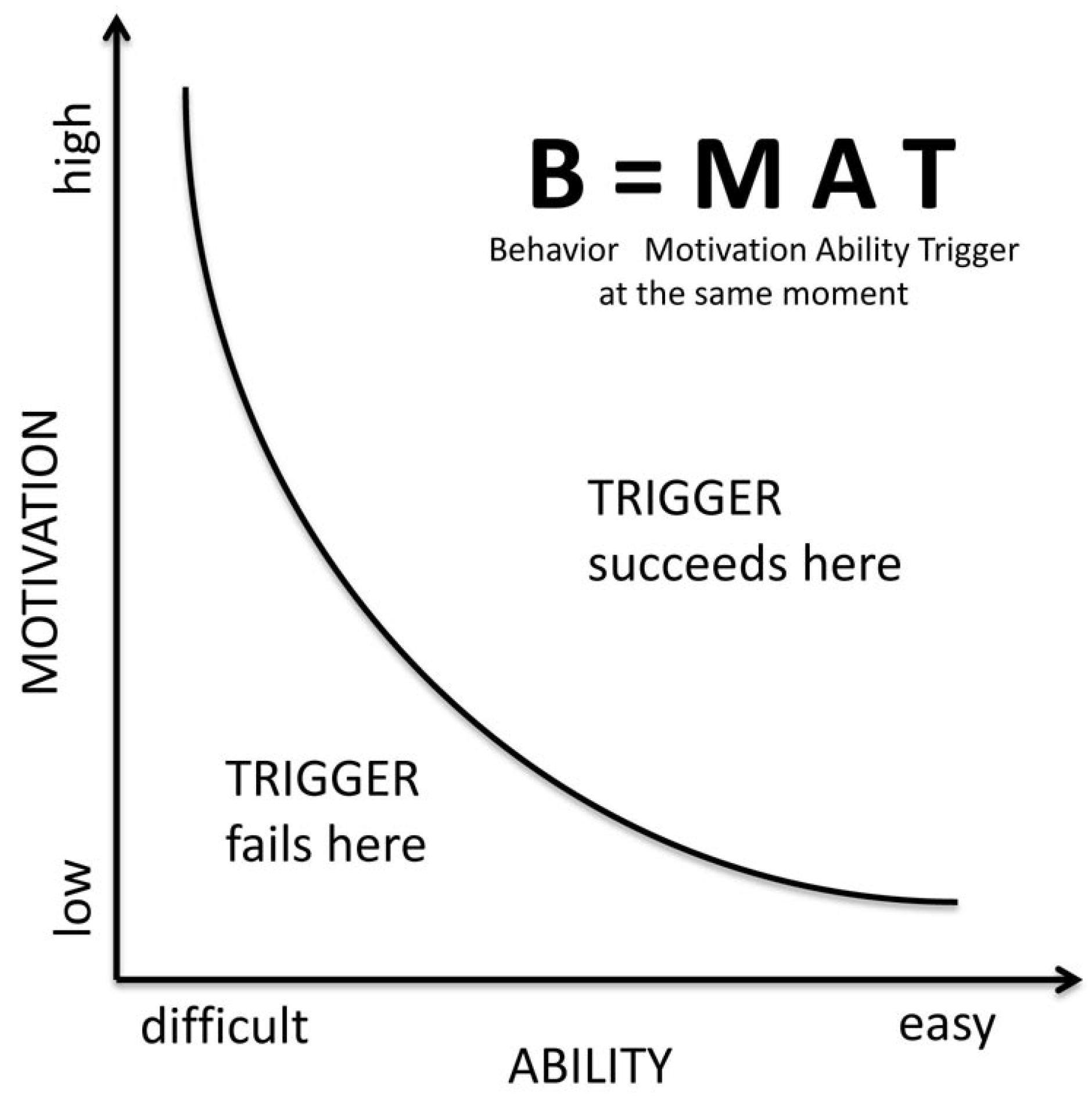
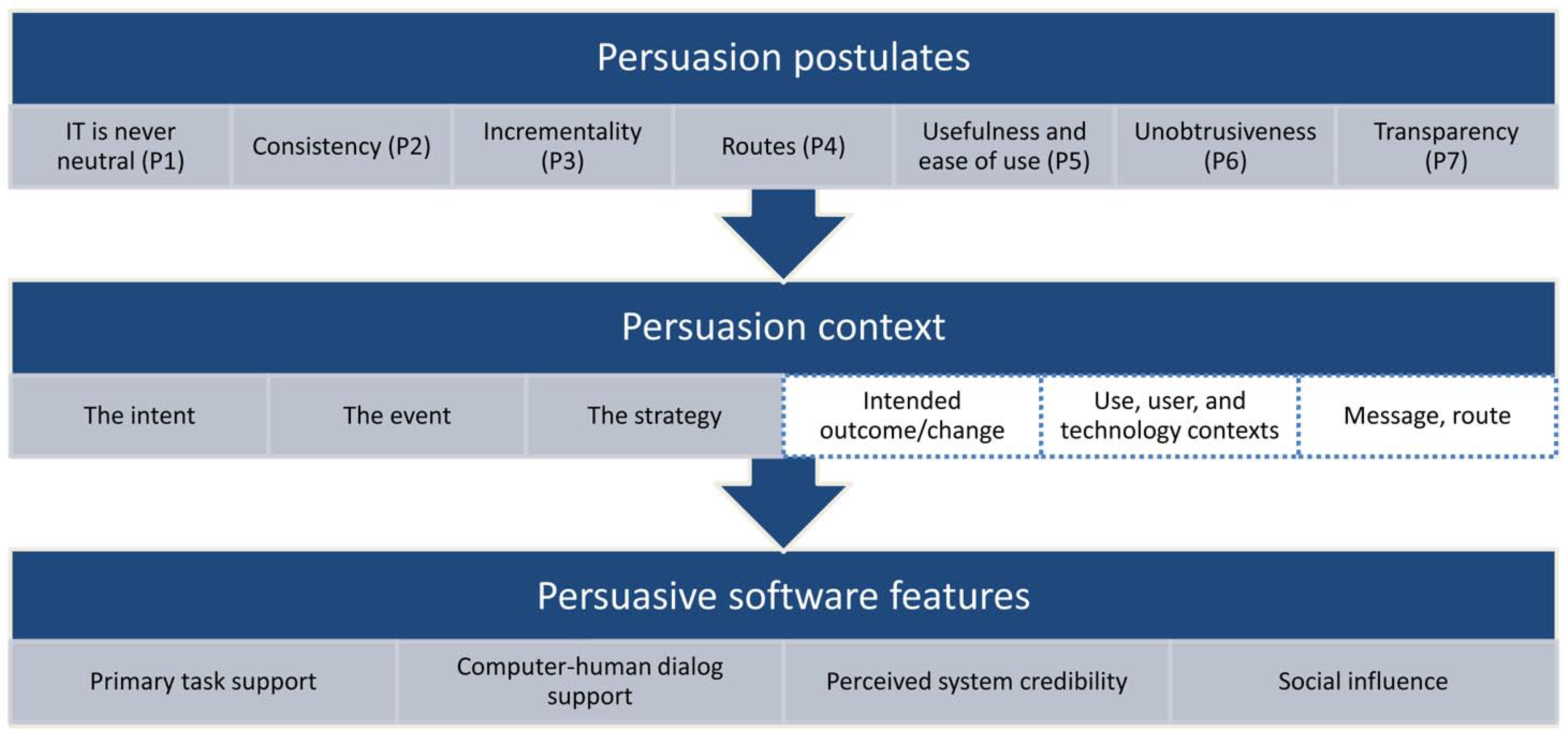
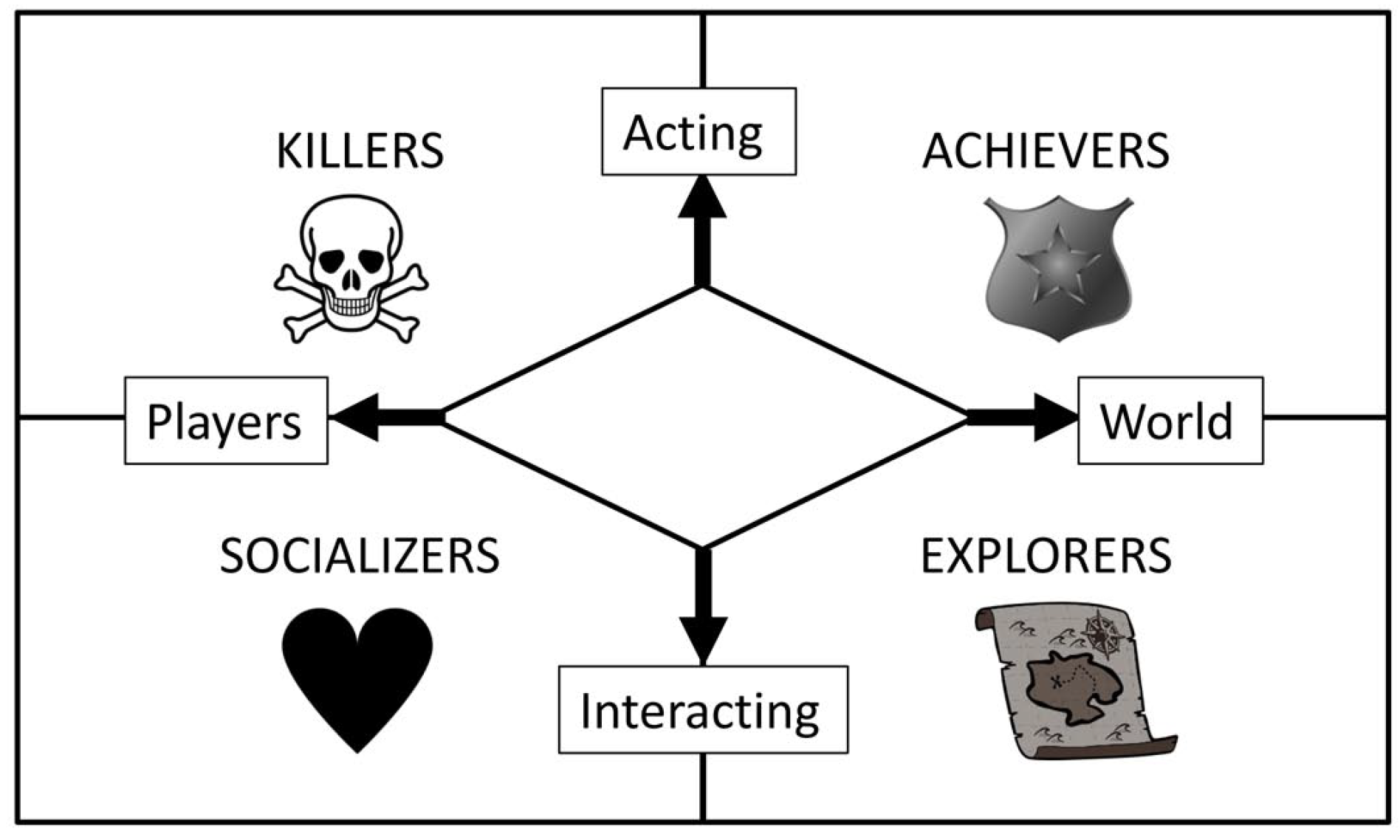
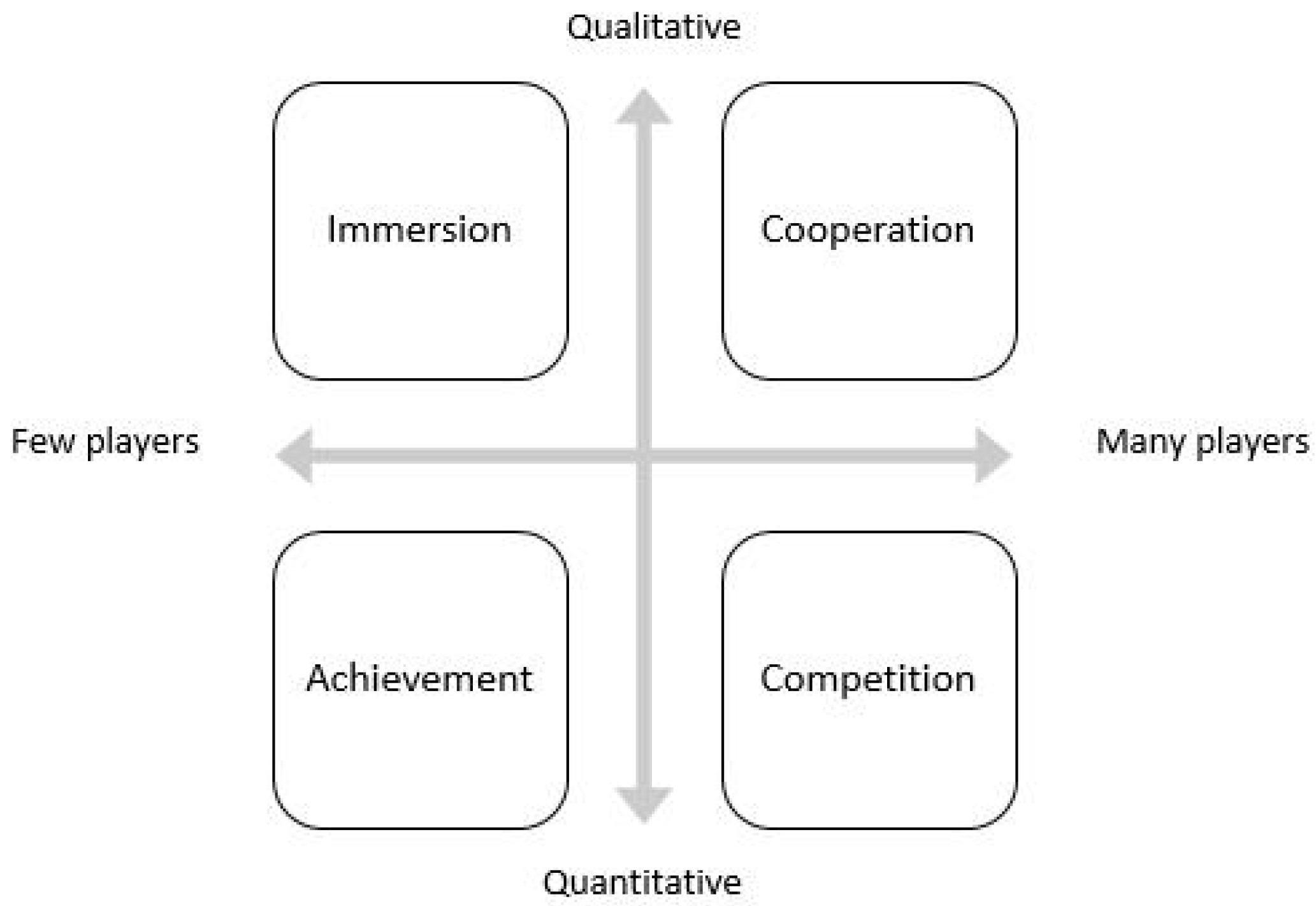
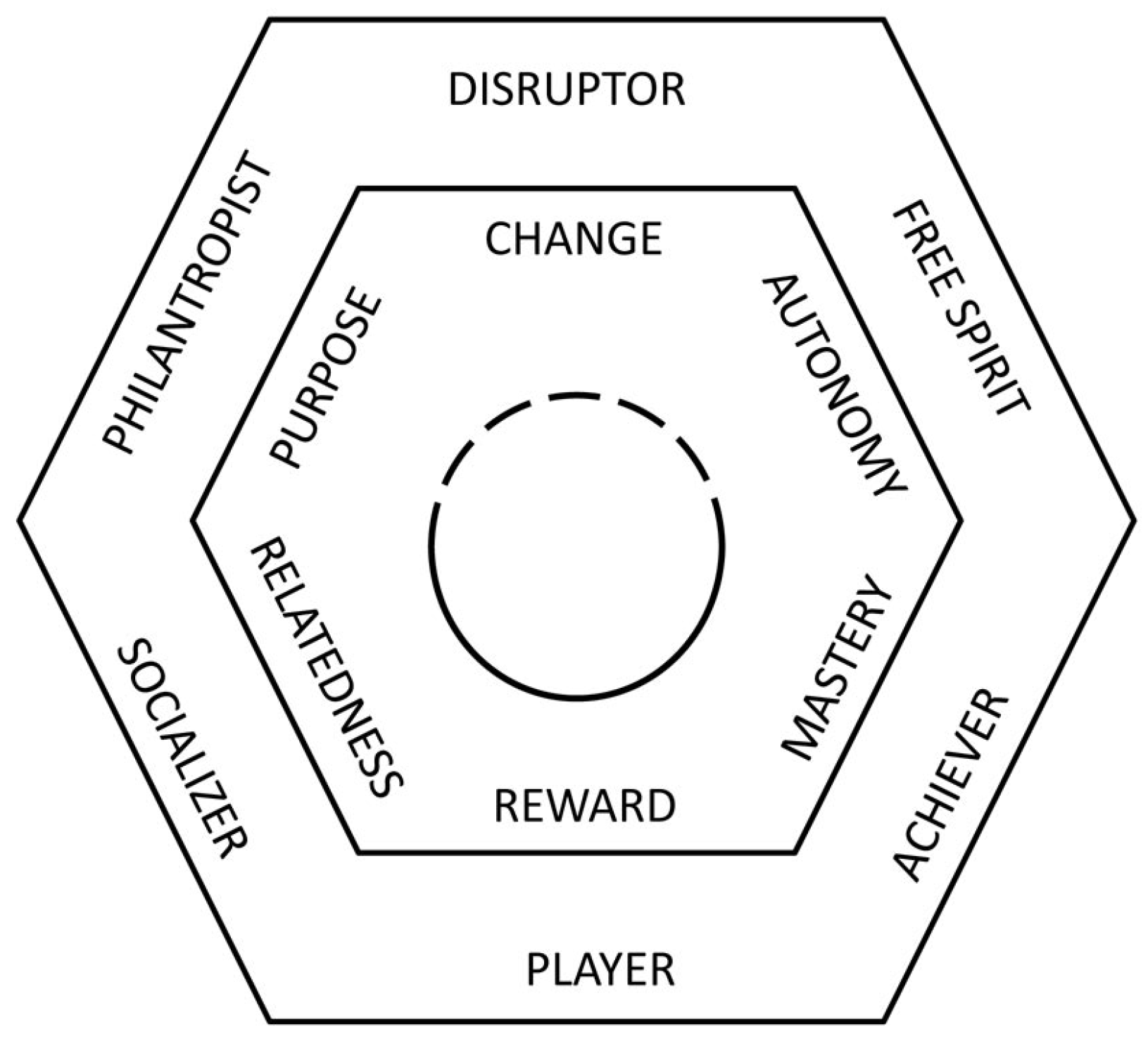
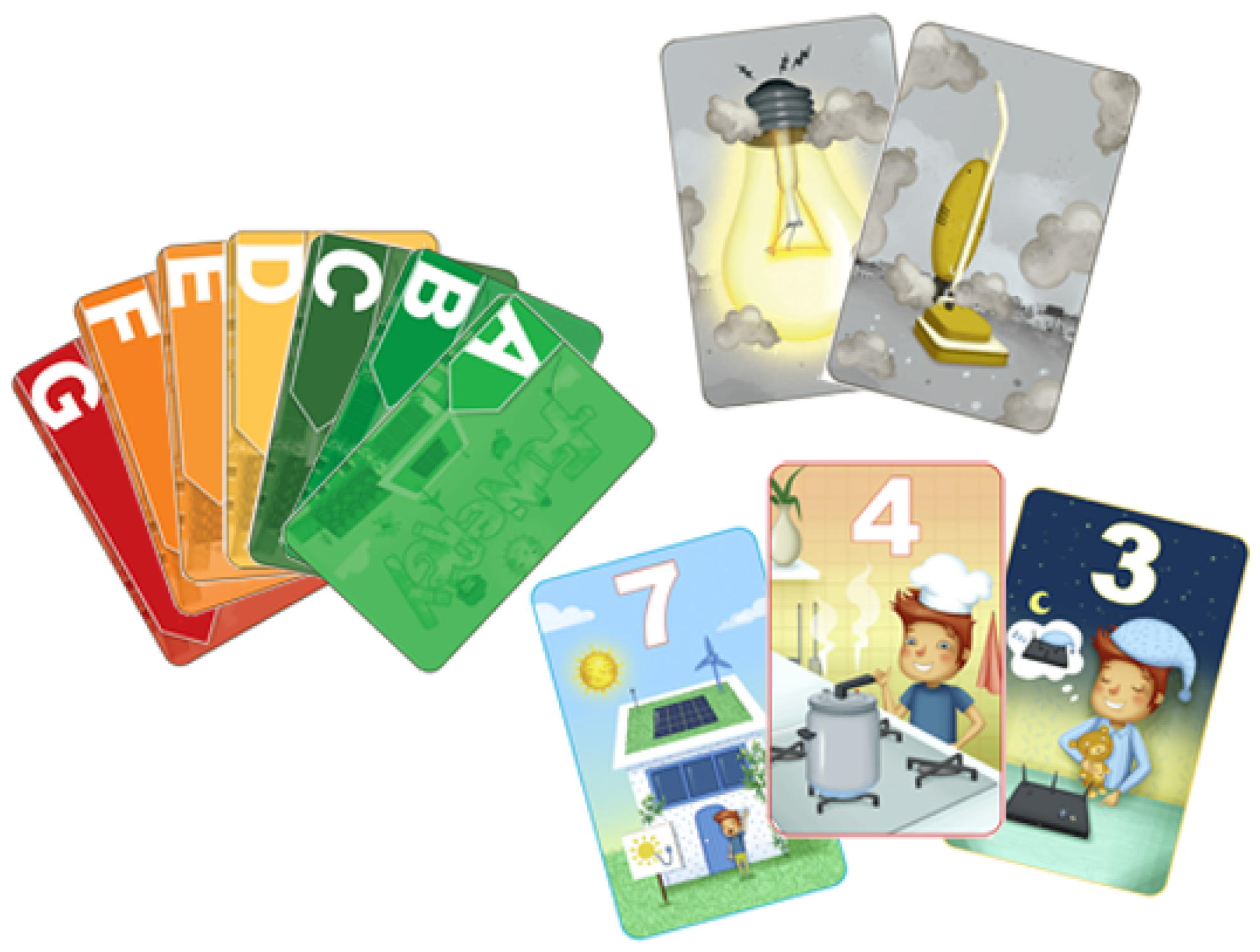
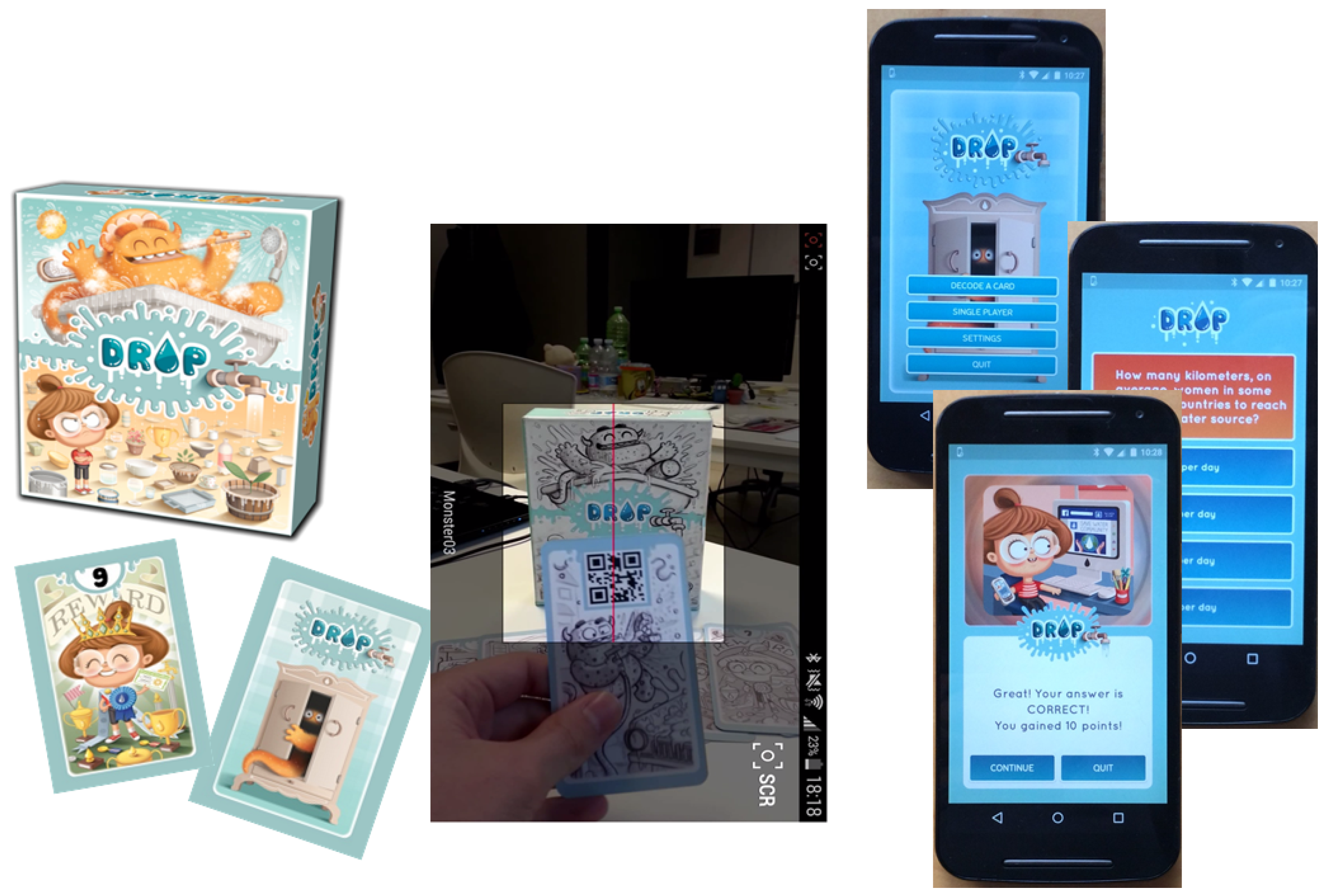
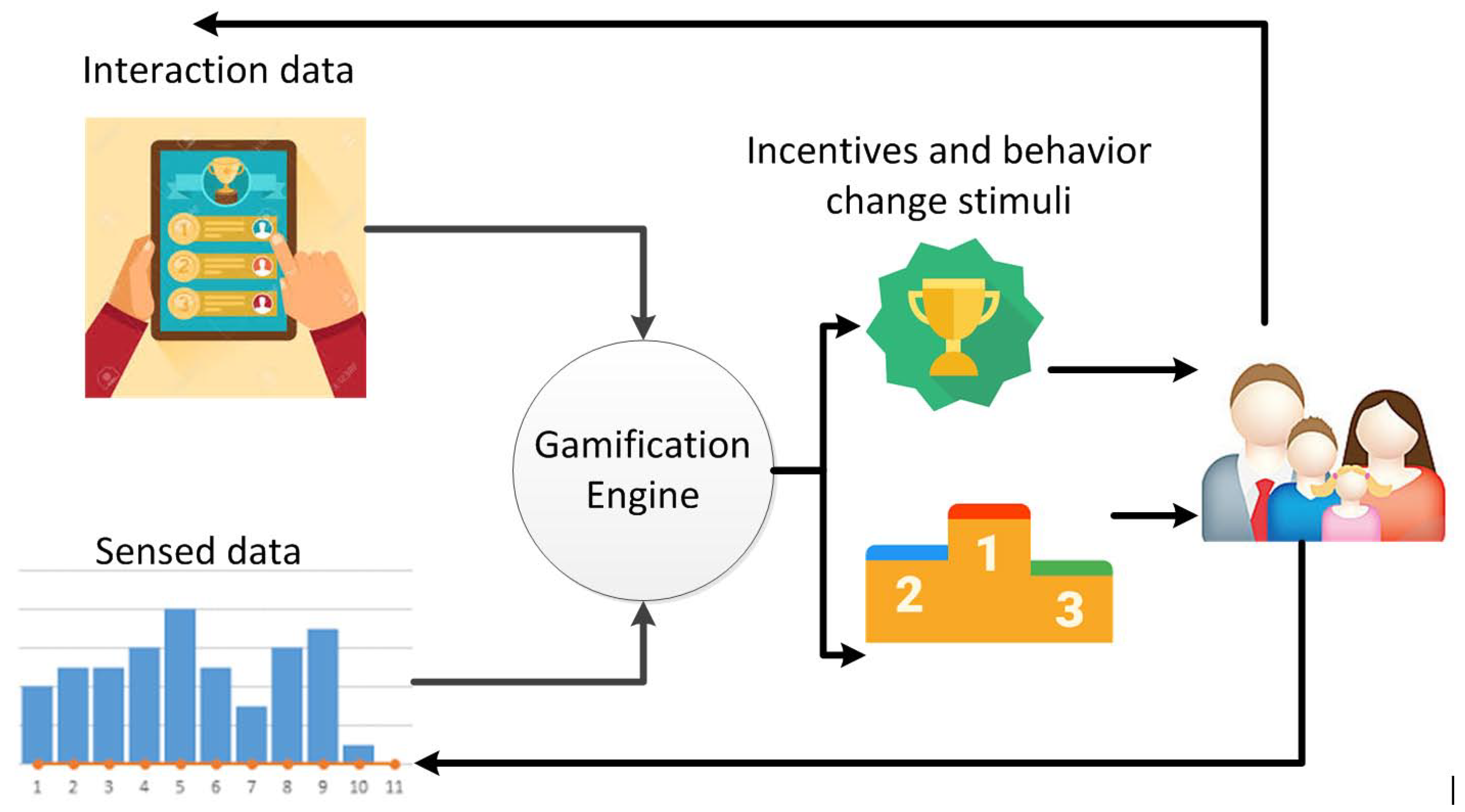
| C-Change | B-Change | A-Change | |
|---|---|---|---|
| F-Outcome | Forming an act of complying | Forming a behaviour | Forming an attitude |
| A-Outcome | Altering an act of complying | Altering a behaviour | Altering an attitude |
| R-Outcome | Reinforcing an act of complying | Reinforcing a behaviour | Reinforcing an attitude |
| eVIZ | ecoPet | Joulebug | WeSpire | Plan It Green | Water Wars | Atoll Game | |
|---|---|---|---|---|---|---|---|
| Technology | Unity 3D | N/A | Android/iOS | Web/Android/iOS | Flash | N/A | VisualWorks and CORMAS platform |
| Roles | Residence Occupant/Family | Family | Family | Shareholders | Policymaker/Mayor | Stakeholders | Family |
| Feedback | Continues Real Time feedback of the user actions over the environment | Tips, in-game alerts | Continuous feedback on money saved and CO2 reduction | In game alerts | No Feedback | Message | N/A |
| Mechanics | Simulation | Challenge Based | Achievements based on action fulfillment | Challenge Based | Simulation | Turn based | Rpg computer assisted |
| Issues | Energy Consumption Reduction | Raise awareness and energy conservation | Sustainability and resource management | Resource Management | Energy Urban Planning | Policies, variable weather conditions | Policies, variable weather conditions, scarcity |
| Players | Single Player | Single Player | Single Player (Social competition) | Single Player | Single Player (Social Competition) | Multiplayer with chat | Up to 16 players |
| Focus | Domestic Energy preservation | Consumption and waste reduction | Energy and water efficient use | Emission, energy, water, waste and fuel management | Energy efficiency and community wellbeing | Interaction among inhabitants | Land/water allocation conflicts |
| Target | Household Residents | Students/Young adults | Teenagers and young adults | Employees | Students | New Mexico residents | Tarawa atoll residents and policy makers |
| Platform | PC/Oculus Rift | PC | Mobile devices | Web and mobile devices | Web | Web and mobile devices | PC supported board game |
| Data collection | Simulated Data | N/A | Connects with Utilities | N/A | N/A | Interviews | Semi-automatic software |
| The Basin Challenge/Catchment Detox | FloodSim | Aqua Republica | Irrigania | Run the River | SeGWADE | Drop! The Question | |
|---|---|---|---|---|---|---|---|
| Technology | Flash | Flash | Unity | VisualBasic ASP.NET | N/A | HTML5 and WebGL | Java |
| Roles | Policymakers | Flood policy strategist | Mayor | Farmer | Decision maker | Water Distribution Systems managers | Water expert |
| Feedback | Messages in game and leaderboard | Messages in game | Messages in game | No feedback | In game alerts | Continuous and instant feedback to players | No feedback |
| Mechanics | Turn based | Turn based | Turn based | Turn-based strategy game | Simulation | Model simulation | Trivia |
| Issues | Policies, variable weather conditions, scarcity | Floods | Policies, variable weather conditions | Governance and management of common resources | Balancing water use between various water consumers | Water Distribution Systems design decisions | General water culture |
| Players | 1–2 players | Single player | Single player | Single player | Single player | Single player | Single player |
| Focus | Manage a river catchment | Raising awareness on flooding policies | Conflicts and trade-offs in a river basin | Water sharing policies, water scarcity | Water management policies | Drinking water distribution systems | Interesting facts on water and water consumption |
| Target | Teenage students | UK residents | Everyone | Students | Kids | Students | Family |
| Platform | Web | Web | Web (portable) | Web | Mobile phones and tablets | Windows, Linux, iOS and Android | Android mobile devices |
| Data collection | N/A | N/A | Numerical models (Mike Basin) | Discussion in class | Based on actual and modelled historic data | Feedback computed with hydraulic simulation engine based on EPANET | N/A |
| ecoGator | Social Power Game | Makahiki | Power House | Less Energy Empowers You (LEY) | Wattsup | enCOMPASS and Funergy | |
|---|---|---|---|---|---|---|---|
| Technology | Java | Java/Objective C | Javascript/Python | N/A | Java | Javascript | Java |
| Roles | Family | Family | Student | Family | Family | Student | Family and employees |
| Feedback | Messages in game | Messages in game | No feedback | No feedback | N/A | Alert in game | Mobile notifications |
| Mechanics | Trivia | Challenge based | Challenge based | Simulation and strategy | Challenge based | Challenge based | Achievement and challenge based |
| Issues | Consumption awareness and decision making | Community engagement in energy saving and awareness | Energy waste, consumption awareness | Raise awareness and energy conservation | Consumption awareness and behavioural change | Energy consumption reduction | Raise awareness and energy conservation |
| Players | Single player | Multiplayer | Single player (Social competition) | Single player | Single player | Single player (Social competition) | Single player (Social competition) |
| Focus | Choosing energy efficient devices | Energy efficiency and community wellbeing | Engaging individuals in energy saving and raising awareness | Engagement in energy efficiency and waste reduction | Consumption and waste reduction | Consumption and waste reduction | Energy efficiency and behavioural change |
| Target | General Public | Swiss residents | Students | Kids and teenagers | General public | Students | Household inhabitants and public building employees |
| Platform | Android | Android and iOS | Web | Windows | Android | Web (Facebook App) | Android and iOS |
| Data collection | N/A | Connects with Utilities | Smart meters | Simulated Data | Smart meters | Smart meters | Connects with Utilities |
| Water Mansion | Water Flavors | Water Saving Calculator | |
|---|---|---|---|
| Technology | Unity | Java | Java |
| Roles | Family | Family | Family |
| Feedback | N/A | N/A | No feedback |
| Mechanics | Simulation | Trivia | Trivia |
| Issues | Consumption awareness and money saving | Raise awareness of water consumption and education | Consumption awareness and money saving |
| Players | Single player | Single player | Single player |
| Focus | Efficient water consumption and its relationship with economic savings | Educate about water importance and usage | Educate about water efficient consumption and its relationship with economic savings |
| Target | Family | Domestic consumers | Domestic consumers |
| Platform | Web | Web | Web |
| Data collection | N/A | N/A | N/A |
© 2018 by the authors. Licensee MDPI, Basel, Switzerland. This article is an open access article distributed under the terms and conditions of the Creative Commons Attribution (CC BY) license (http://creativecommons.org/licenses/by/4.0/).
Share and Cite
Albertarelli, S.; Fraternali, P.; Herrera, S.; Melenhorst, M.; Novak, J.; Pasini, C.; Rizzoli, A.-E.; Rottondi, C. A Survey on the Design of Gamified Systems for Energy and Water Sustainability. Games 2018, 9, 38. https://doi.org/10.3390/g9030038
Albertarelli S, Fraternali P, Herrera S, Melenhorst M, Novak J, Pasini C, Rizzoli A-E, Rottondi C. A Survey on the Design of Gamified Systems for Energy and Water Sustainability. Games. 2018; 9(3):38. https://doi.org/10.3390/g9030038
Chicago/Turabian StyleAlbertarelli, Spartaco, Piero Fraternali, Sergio Herrera, Mark Melenhorst, Jasminko Novak, Chiara Pasini, Andrea-Emilio Rizzoli, and Cristina Rottondi. 2018. "A Survey on the Design of Gamified Systems for Energy and Water Sustainability" Games 9, no. 3: 38. https://doi.org/10.3390/g9030038
APA StyleAlbertarelli, S., Fraternali, P., Herrera, S., Melenhorst, M., Novak, J., Pasini, C., Rizzoli, A.-E., & Rottondi, C. (2018). A Survey on the Design of Gamified Systems for Energy and Water Sustainability. Games, 9(3), 38. https://doi.org/10.3390/g9030038





